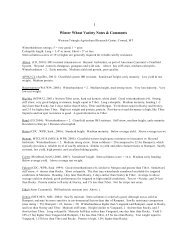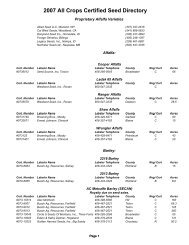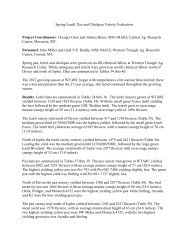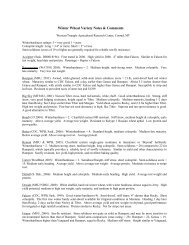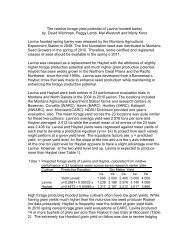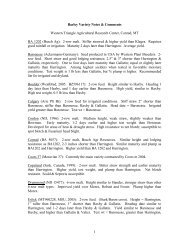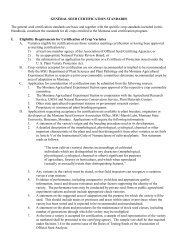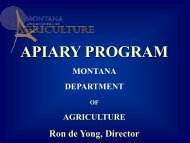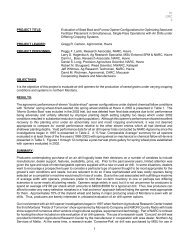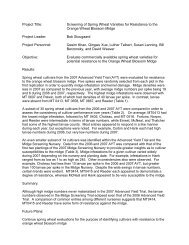Fall 2012 - College of Agriculture - Montana State University
Fall 2012 - College of Agriculture - Montana State University
Fall 2012 - College of Agriculture - Montana State University
Create successful ePaper yourself
Turn your PDF publications into a flip-book with our unique Google optimized e-Paper software.
ImID Focusing on Health Disturbances<br />
Research in Immunology & Infectious<br />
Diseases (ImID) focuses on the development<br />
<strong>of</strong> new drugs, vaccines and diagnostic<br />
tools for fighting infectious diseases <strong>of</strong><br />
livestock, humans and wildlife. Jovanka<br />
Voyich-Kane, assistant pr<strong>of</strong>essor, is researching<br />
Staphylococcus aureus — a common<br />
bacterium found on human skin and in<br />
nasal passages. Although this organism can<br />
be a benign inhabitant, it can also cause<br />
skin infections, bacteremia, endocarditis,<br />
sepsis and toxic shock syndrome, according<br />
to Voyich-Kane. “Our lab focuses on how<br />
the bug causes disease in healthy humans.”<br />
“S. aureus is one <strong>of</strong> the most common causes<br />
<strong>of</strong> skin-and s<strong>of</strong>t-tissue infections in the<br />
United <strong>State</strong>s,” said Voyich-Kane. “These<br />
infections are very contagious and painful,<br />
and drug resistant strains are difficult to<br />
effectively treat,” she added.<br />
While the staph bacterium is dangerous for<br />
humans, it also is a problem in livestock.<br />
Voyich-Kane’s research team is investigating<br />
incidence and characteristics <strong>of</strong> S. aureus<br />
in <strong>Montana</strong>’s dairy herds and studying the<br />
antimicrobial potential <strong>of</strong> a chemokine (a<br />
signaling protein) found in bovine milk.<br />
“We want to learn more about immunity to<br />
S. aureus and the prevalence <strong>of</strong> S. aureus in<br />
<strong>Montana</strong>’s dairy herds and also in horses,”<br />
said Voyich-Kane. Staph is one <strong>of</strong> the most<br />
frequent causes <strong>of</strong> mastitis in cattle, which<br />
impacts milk production.<br />
The bacterium can also cause bad infections<br />
in horses. Voyich-Kane’s research team comprised<br />
<strong>of</strong> faculty and students is working<br />
with Dr. Shannon Moreaux, veterinarian<br />
and assistant pr<strong>of</strong>essor in the Department<br />
<strong>of</strong> Animal & Range Sciences. They are<br />
looking at the percentage <strong>of</strong> horses carrying<br />
the bacterium and trying to determine<br />
if they might be a reservoir for S. aureus.<br />
Investigators are surveying several ranches<br />
in the Gallatin Valley and tracking the<br />
presence <strong>of</strong> the bacterium. “We are focusing<br />
on the incidence and transmission potential<br />
<strong>of</strong> S. aureus in <strong>Montana</strong>’s equine populations,<br />
and also looking at the potential for<br />
cross contamination between cattle, horses<br />
and people,” added Voyich-Kane.<br />
ImID is also supporting a project for<br />
junior faculty member Josh Obar. Obar is<br />
investigating the role <strong>of</strong> mast cells in the<br />
progression <strong>of</strong> Listeria infection. Listeria, a<br />
widespread human and animal disease, is<br />
a common cause <strong>of</strong> food borne illnesses.<br />
In ruminants, it can cause encephalitis,<br />
septicemia, late-term abortions and on rare<br />
occasions mastitis. According to current<br />
research data, mast cells may be an important<br />
early source <strong>of</strong> inflammatory cytokines<br />
during heat-killed Listeria infection. <br />
Mast Cells: a certain kind <strong>of</strong> white blood cell<br />
involved in immune and allergy responses.<br />
Market Volatility<br />
Disturbances in agricultural commodity<br />
prices are common, and managing the<br />
volatility is important. Pr<strong>of</strong>essors Gary<br />
Brester and Eric Belasco, Department <strong>of</strong><br />
Agricultural Economics & Economics<br />
faculty, <strong>of</strong>fer senior-level marketing and<br />
management courses to train students in<br />
commodity price risk management —<br />
diversification, forward contracting,<br />
hedging and commodity options.<br />
The <strong>College</strong> and <strong>Montana</strong> businesses<br />
collaborated on the course design. Brent<br />
Poppe, a loan <strong>of</strong>ficer with Stockman Bank,<br />
believed students would learn more with real<br />
money. Stockman Bank, Billings Wells Fargo<br />
Bank and the <strong>Montana</strong> Wheat and Barley<br />
Committee provided funds so classes could<br />
obtain a position in the market. Charley<br />
Switzer, owner <strong>of</strong> Pr<strong>of</strong>essional Commodity<br />
Management in Bozeman, assists the students,<br />
who then monitor and evaluate the portfolio.<br />
Commodity options markets are a way to<br />
manage price risk — a type <strong>of</strong> price insurance,<br />
explained Brester. During the semester,<br />
pr<strong>of</strong>essors <strong>of</strong>fer student teams real world<br />
scenarios: a feedlot manager concerned with<br />
increases in feeder cattle prices or a wheat<br />
producer concerned about price decline.<br />
The class votes as a group to purchase a put<br />
or call option.<br />
Belasco noted the course helps students<br />
learn processes used by producers and<br />
agribusinesses to manage price risk. “It is<br />
an investment in the future, the business<br />
and future employees. They won’t mess up<br />
later — knowing and understanding the risk.<br />
As an employee they are ahead <strong>of</strong> the game.”<br />
Mitch Grove, originally from Highwood,<br />
Mont., graduated from MSU in 2011 with a<br />
double major in economics and agricultural<br />
business, and works as a farm loan <strong>of</strong>ficer for<br />
the <strong>Montana</strong> Farm Service Agency. Grove<br />
recalled his class voting on a speculative<br />
position in the cattle market because they<br />
thought it had the most chance <strong>of</strong> success.<br />
They purchased a “put” option on live cattle.<br />
The Japanese tsunami caused cattle prices<br />
to decline, and they were able to capitalize<br />
on their option much like a cattle processor<br />
would in the same situation.<br />
“(Dr. Brester) made us watch the world<br />
market. One event can throw the market<br />
and cause significant changes. Hedging (the<br />
process <strong>of</strong> purchasing a put option) worked<br />
well for us,” said Grove. “We got little<br />
return after we paid the broker and made<br />
our moves, but the idea wasn’t to speculate<br />
to make money, but rather, to protect our<br />
presumed business from declines in fed<br />
cattle prices.”<br />
Grove helps producers protect themselves<br />
from price declines using futures and options<br />
markets, and credits the classes with helping<br />
him better understand a global economy.<br />
Jessica Lacey, a senior from Folsom, Calif.,<br />
is majoring in Agricultural Business with<br />
a minor in economics, and took the<br />
marketing course from Belasco. Her team<br />
purchased a call option, but feeder cattle<br />
prices declined. “As a speculator we chose<br />
wrong — as a producer it would have been<br />
ok,” said Lacey.<br />
“The spring class purchased a call for $1,600<br />
and basically ended with no value. Losing<br />
was probably a better learning experience<br />
for them,” said Blasco. “Having money<br />
helped keep their interest and demonstrated<br />
the dynamics <strong>of</strong> investor psychologies.” <br />
8



